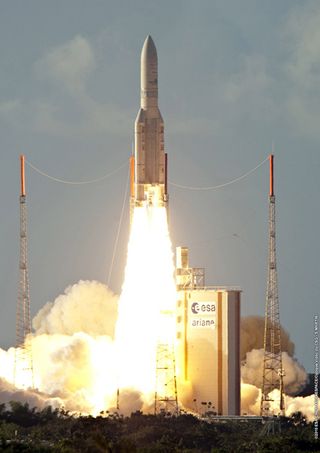European Rocket Launches 2 African Satellites

Europe'sAriane 5rocket accomplished its third commercial mission of the year Wednesday,delivering to orbit two African communications satellites to broadcasttelevision programming and boost connectivity with rural villages.
The166-foot-tall launchertook offat 2059 GMT (4:59p.m. EDT) and soared into partly cloudy skies over the French-run spacebase inKourou, French Guiana. After turning east from the South Americancoast, theAriane 5 rocketed into the upper atmosphere and shed its twin solidrocketboosters about 2 minutes, 15 seconds after liftoff.
Therocket's hydrogen-fueled first stageconsumed its propellant in 9 minutes and gave way to a cryogenic upperstagethat ignited a few seconds later.
Thesecond stage burned for nearly 16minutes, completing a high-speed transit of the Atlantic Ocean beforedeployingits two payloads in view of ground stations in Gabon and Kenya.
Nilesat201 separated just shy of theflight's 29-minute mark, followed by the jettison of the Ariane's Syldadual-payload adapter less than 2 minutes later. The second stagereleasedRascom-QAF 1R less than 33 minutes after launch.
Bothsatellites were dropped off in anelliptical transfer orbit stretching from 154 miles to a peak altitudeof22,322 miles. The orbital inclination was 2 degrees.
"Itis the 38th success in a row for Ariane5,and since the beginning of 2010, we have launched six majortelecommunicationssatellite, which is more than all of our competitors together," saidJean-Yves Le Gall, Arianespace's chairman and CEO. [Ariane5 Rocket Launches on 50th Mission]
Get the Space.com Newsletter
Breaking space news, the latest updates on rocket launches, skywatching events and more!
Eachspacecraft is beginning several weeks oforbit-raising engine firings, critical deployments, and testing beforethey arehanded over to operators in September. Both satellites were built byThalesAlenia Space of France.
Nilesat201 will enter service at 7 degreeswest longitude, joining two other Nilesat spacecraft and aEuropean-ownedsatellite to provide direct-to-home television, radio and broadbandInternetservices to Africa and the Middle East.
"Itwill play an important role in thedynamic broadcasting and emerging global markets in the Middle East andNorthAfrica," said Reynald Seznec, CEO of Thales Alenia Space. "It isfitted with powerful state-of-the-art Ku-band and cutting edge Ka-bandtechnology."
Thesatellite carries 24 Ku-band and fourKa-band transponders for Nilesat, Egypt's state-controlledtelecommunicationscompany.
"Iwould like to congratulate the teamof Nilesat for the successful launch of Ariane 5 and Nilesat 201," saidAnas El Feky, Egypt's information minister. "We are truly proud of whatyou achieved tonight. It's a great achievement for the Egyptian mediaand addedvalue to the Nilesat company, which has been very successful in ourregion."
Rascom-QAF1R was ordered to replace a nearlyidentical satellite crippled by a helium leak after launch in 2007. Theglitchforced the first Rascom-QAF satellite to burn more propellant thanexpected,reducing its useful life from 15 years to two or three years.
"Two-and-a-halfyears ago, we were justwitnessing the launch of the first satellite," said Faraj Elamari, CEOofRascomStar-QAF, an African satellite company. "Well, we had to do ittwice. It look a lot of determination and our motivation hasn'tchanged."
RascomStar-QAFwas founded by a consortium ofAfrican and European investors, including Thales Alenia Space, aLibya-basedinvestment fund, and RASCOM, a satellite communications organizationwithmembers in 45 African nations.
"Thisis a big day before us because wehave been on the journey for the Rascom project right from the start asone ofthe shareholders and also as prime (contractor) for the satellite,"Seznecsaid.
Rascom-QAF1R will be stationed at 2.85degrees east longitude with 12 C-band and eight Ku-band transponders,beamingtelevision, telephone and Internet services across Africa.
"Thanksto Rascom-QAF 1R and itsassociated ground equipment, Africa will be able to benefit fromcommunicationsin rural areas at an affordable cost, communications between regionalcapitalsand cities, and between cities and villages," Elamari said.
Accordingto Elamari, Rascom-QAF 1R will helpconnect up to 150,000 rural villages to communications networks.
Inremarks following Wednesday's missions, LeGall announced two new contracts for Arianespace. The company willlaunch theGSAT 10 satellite for India and the Intelsat 20 communications craftcoveringthe Asia-Pacific region.
Thecompany has a backlog of 22 Ariane5 launchesand 17 flights of the Soyuz rocket, which will make its first launchfromKourou in December or early 2011.
Thenext Ariane 5 mission is scheduled forSept. 15 with European and Japanese payloads. Another dual-satellitelaunchwill follow in October or November, and Arianespace will wrap up 2010with thedelivery of an unmanned cargo ship for the International Space Station.
- Gallery- Liftoff! SpaceX's Falcon 9 Rocket First Launch
- Photos? Last Flight of Space Shuttle Atlantis
- SpaceShuttle Launch Seen From Jet Fighter
Copyright 2010 SpaceflightNow.com,allrights reserved.

Join our Space Forums to keep talking space on the latest missions, night sky and more! And if you have a news tip, correction or comment, let us know at: community@space.com.
Stephen Clark is the Editor of Spaceflight Now, a web-based publication dedicated to covering rocket launches, human spaceflight and exploration. He joined the Spaceflight Now team in 2009 and previously wrote as a senior reporter with the Daily Texan. You can follow Stephen's latest project at SpaceflightNow.com and on Twitter.
